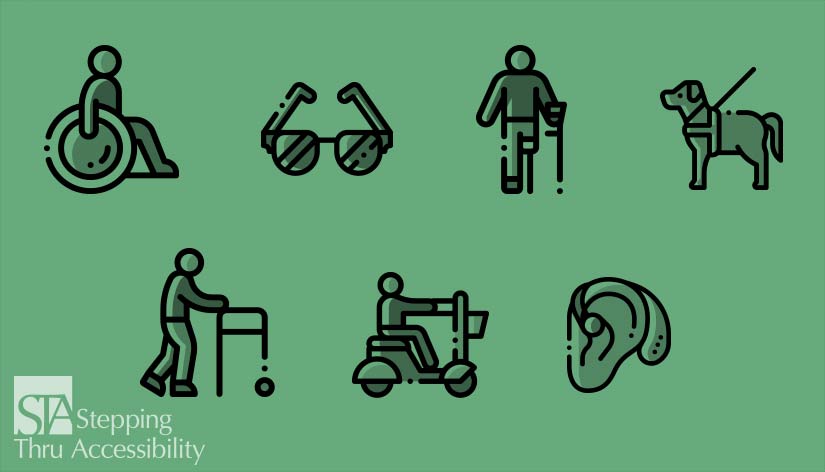Blog
Return to Blog »
Janis Kent, FAIA Architect, CASp © January 2019 Time and again, I find that there is often confusion about what Access means and who it is for. There is this overlying presumption that it is only, or let us say mostly, for people who use wheelchairs. Just the other night someone was telling me how silly it was that a project they were altering was required to have an accessible restroom on the second floor even though the building does not have an elevator. So the real question is – what are we doing and for who is it for. About half of the people who are considered disabled do have issues with mobility. This is not only someone who uses a wheelchair but also someone who uses a cane, or crutches, or walker, or someone who has a balance issue where walking is difficult without support, or someone who has difficulty breathing who just can not walk distances. And be aware that just because one uses a wheelchair does not mean that person is paralyzed and can not walk. There are indeed some people who have to always use a wheelchair and may not even be able to get in and out of it by themself. But the wheelchair or any other mobility aid, are items that allow people independence rather than limiting them. This grouping of disabilities has to do with vision and hearing. In the younger segments of our population, hearing and vision disabilities are about the same percentage, and as one ages, the percentage does increase. By the time we hit retirement age, hearing disability is almost double that of vision. For those who are hearing impaired, whether deaf or hard of hearing, we tend to think of technical or mechanical solutions since this is the manner the ADA Standards provide in the requirements. But there are many design considerations for this type of disability beyond just audio/visual-type of electronics. And rather than thinking of this segment of our population as someone who can not hear, rather think of it as someone who has a heavy reliance on Seeing or Sight. For those with vision disabilities, whether partially sighted or blind, we generally think of tactile signs or tactile flooring solutions such as detectable warnings. Those who are blind tend to statistically be less independently mobile in the community. More of a reliance is placed on sound, smell, and touch and that is not how our environment is purposefully designed. We generally do not think of cognitive disabilities when designing our facilities, particularly since there are no designated requirements. But these types of disorders can be mild to severe and affects a large portion of our population. This can affect our ability to learn, our memory, our perceptions, and our ability for problem solving. It is a broad category and can include those on the spectrum (previously referred to as autism), or those with other cognitive dysfunctions whether dementia, or retardation, or schizophrenia, or anxiety. There are other disabilities that do not fit in the above groupings. One notable is the inability or difficulty of lifting and grasping. This affects a percentage of our population that is actually greater than those with communication disabilities. This difficulty can stem from arthritis, or paralysis, or not having usable hands. And there are people who can not speak or vocalize. So going back to that 2-story non-elevatored building with an accessible bathroom on the second floor, the question is, what does it do for us. I might be in a wheelchair but can be mobile. I can very carefully walk up the stairs, have someone carry my chair for me, then get back into my chair and move independently. Same goes for a walker. If I have balance issues or am elderly I can use handrails to guide myself up the stairs and can make use of grab bars in a toilet room. And the same goes if I can not see well or at all. While looking at what can go wrong with the human body can be quite distressing, there is another way of viewing this. What we are doing is building and maintaining our environment with an understanding of Access overall that allows us to be as independent as possible for as long as possible, and to continue to do what we love whether it is a disability caused by birth, or accident, or disease, or just plain aging. This includes riding a bike with hand peddles attached to a wheelchair, or a ramp down to a dance floor, or textured flooring to assist with wayfinding. It can also include transparent/translucent doors or corners in corridors so people are visible if they can not be heard. Or it can be a calming space, a place to orient yourself outside of the crowd. The answer to the initial question is, it is about all of us, and it will indeed affect all of us at some point in our life, whether us personally, or a spouse, or parent, or friend, or child. So the more we do now, the better off all of us are, and this is about going two steps beyond codes and regulations. Be aware that your local City or County may have additional requirements that are more restrictive than the State or Federal requirements. Also, this article is an interpretation and opinion of the writer. It is meant as a summary – current original regulations should always be reviewed when making any decisions. Janis Kent, FAIA Architect, CASp © January 2019Access — Who is it for?

Mobility
Communication Disabilities
Cognitive & Memory Disorders
Miscellaneous